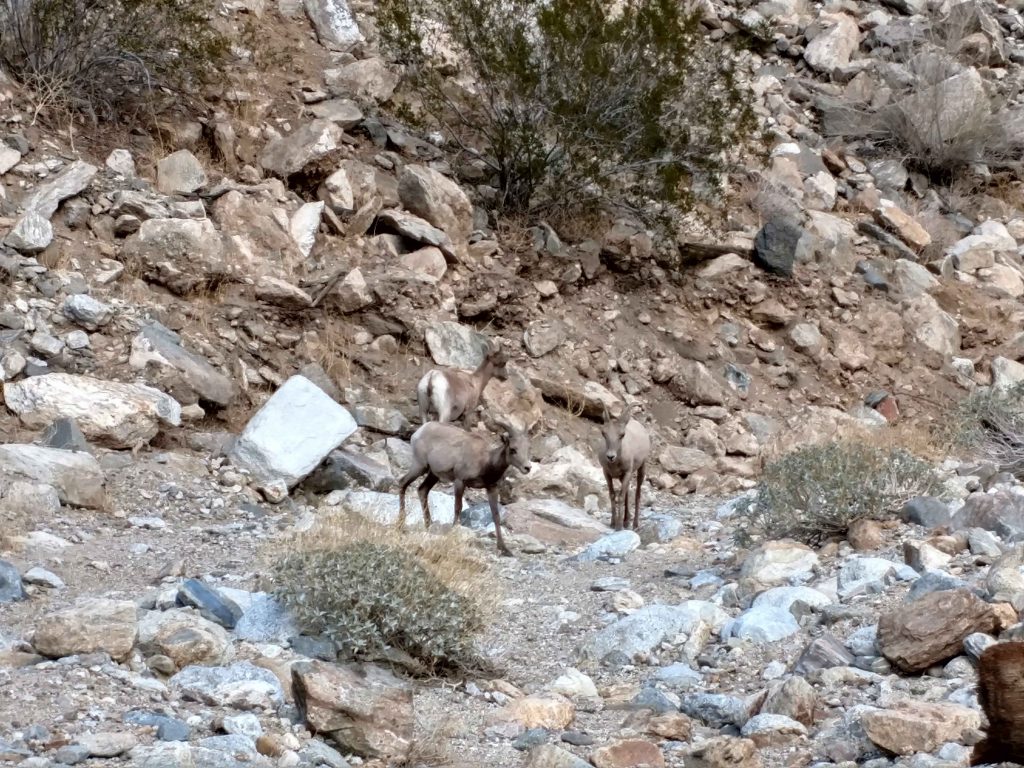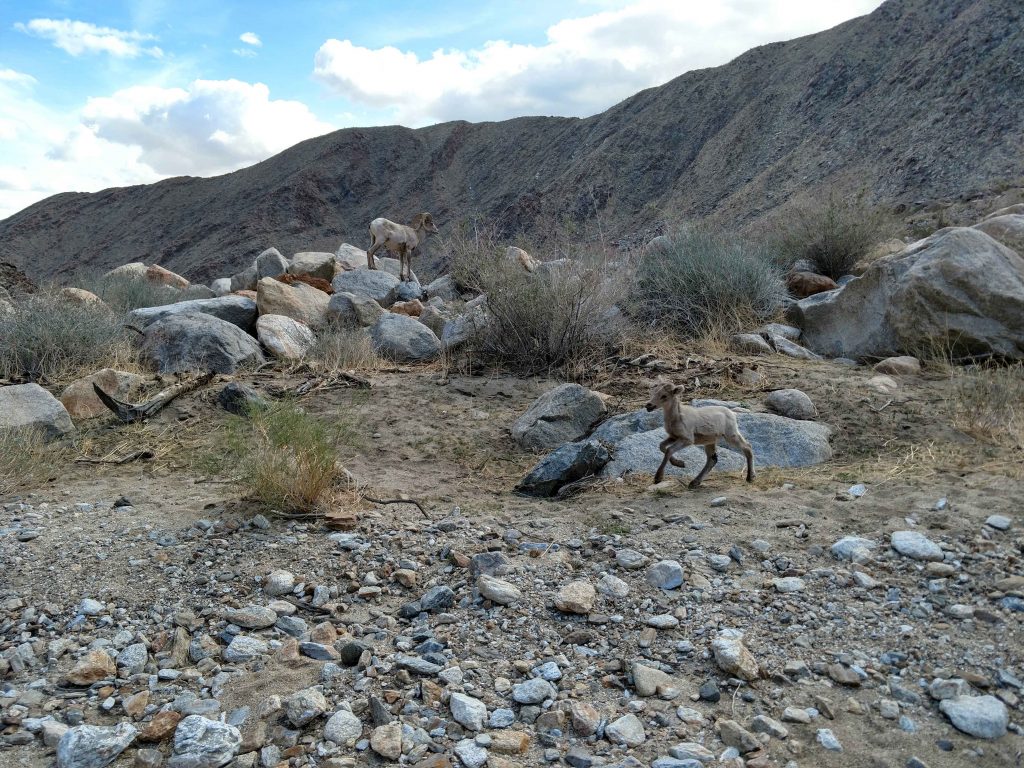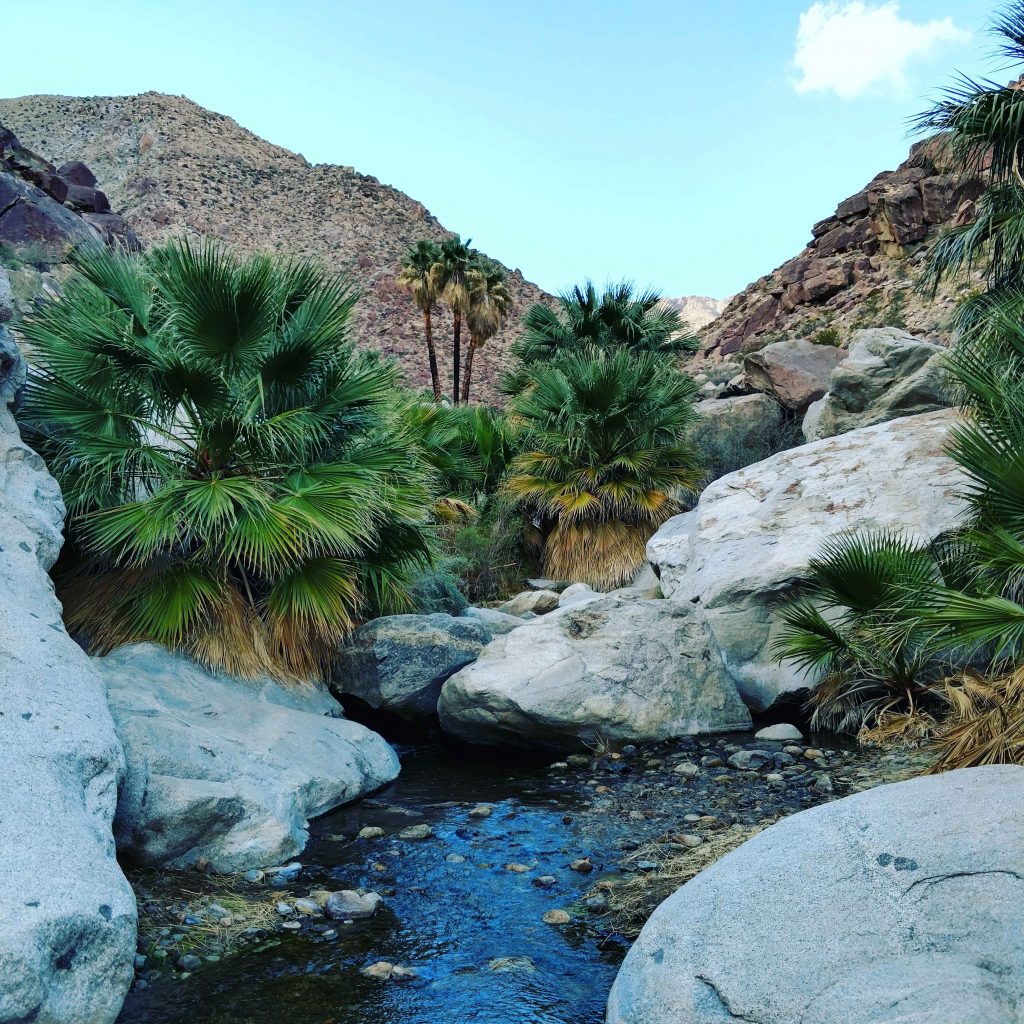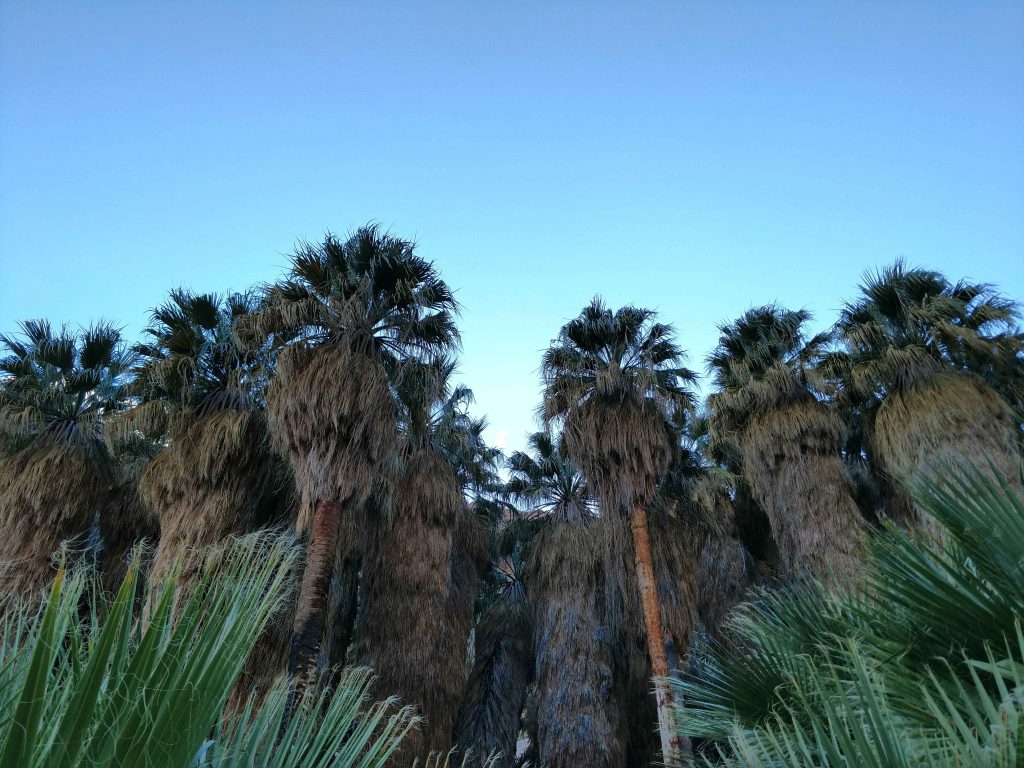Fortunate timing gave us an up close and personal encounter with Desert Bighorn Sheep

This has been a particularly fortuitous spring for me with seeing wildlife spectacles. Between witnessing the
fly-out of 5,000 snow geese at Bosque del Apache and seeing my first bighorn sheep in the wild in the
Sangre de Cristo Mountains, its been grand! But there was more- a reunion in San Diego lead us to a day trip to Anza Borrego Desert State Park where I saw the particularly rare Peninsular Bighorn Sheep in lambing season.
We’ve always enjoying hiking Anza Borrego Desert State Park. In the past I’ve caught the tremendous wildflower blooms and that was what we were hoping to see this trip. Unfortunately, its been a drier year so the wildflowers were spotty. So we settled on hiking a classic- Borrego Palm Canyon. This is a very popular trail that is great to see even on crowded weekends. The main draw is the fantastic oasis at the end of the trail, teeming with California Fan Palms- the only native palm tree in the state. So much of desert life depends on oases like this one which run with water fairly consistently. Most of the pictures I’ve seen of Desert Bighorn Sheep are nearby this canyon so perhaps a sighting is not so rare.

Short but Steep Hike
The trail begins near the park
headquarters and campground. It steadily ascends into a narrowing canyon and the flora becomes noticeably lusher. Its not terribly steep but there’s no water or services on the trail which tends to keep the less experienced hikers away. We were just enjoying the lovely 80 degree temperatures when we stumbled upon the first of dozens.
Desert Bighorn Sheep are also known as Peninsular Bighorn Sheep and are a rare subspecies even when factoring in ideal conservation efforts. They tend to be smaller and more adapted to scarcity than their Rocky Mountain counterparts. They’ve also gone through an incredible comeback over the past 100 years due to extensive conservation efforts. Nevertheless, there’s still roughly 1,000 Desert Bighorns in the wild
[video width="1920" height="1080" mp4="https://quincykoetz.com/wp-content/uploads/2018/05/VID_20180311_153935295.mp4"][/video]
Lambing Season
It was surreal. A heard of roughly 25-30 individuals appeared on the hiking trail like they were trying to be found. Though wary of human presence, they danced about the canyon with playful exuberance. A few of the males also butted heads, making a tremendously loud crack that echoed along the canyon walls. Somewhere in the herd, we came across the imposing alpha male. Grizzled and curled horns and imposing size made him easy to spot. He strutted about in obvious dominance over the herd.
Carefully watching us were about a dozen newborn lambs. Three of them stood at a distance high above the canyon and had to be coaxed by their dam to finally move on. They didn’t have the grace that the fully-grown bighorns had but they could still glide up and down the rocks within the protective sight of their mothers. We even saw a few of them feeding though their mother seemed perturbed.

More Wonders at the Oasis
Not surprisingly, the herd was supported by the reliable water sources of the Palm Canyon Oasis. This is at the end of the trail and a glorious sight to see. It looks like the way a kid would draw it- sheltered in the canyon, towering palm trees and a small creek. Life flourished around the oasis.
The
free trail guide from the park illuminated a fun fact of natural California.
Washingtonia filifera or the California Fan Palm is the only species of palm which naturally occurs in the state. Though frequently cultivated, they grow only in small oases such as this one in the Sonoran desert.


Fan Palms look so funny to me. Standing in the center of them, I felt like I was being appraised by a bunch of elders in a tribe. They sure have a grizzled visage!
There are a few small trails that explore the oasis. Its a perfect spot for a snack or a lunch. Daylight was running out for us so we headed back down the same way we came. On the way down, we saw the herd retreating into the hills- they must sleep up there at night.
For a short hike, it packed a punch! Its somewhat steep and rocky but easily traversed in about 2-3 hours if you're stopping for scenery like we were. Its a popular hike, so it's rare to have any solitude but the chance to see Bighorn Sheep makes it worthwhile.
 This has been a particularly fortuitous spring for me with seeing wildlife spectacles. Between witnessing the fly-out of 5,000 snow geese at Bosque del Apache and seeing my first bighorn sheep in the wild in the Sangre de Cristo Mountains, its been grand! But there was more- a reunion in San Diego lead us to a day trip to Anza Borrego Desert State Park where I saw the particularly rare Peninsular Bighorn Sheep in lambing season.
We’ve always enjoying hiking Anza Borrego Desert State Park. In the past I’ve caught the tremendous wildflower blooms and that was what we were hoping to see this trip. Unfortunately, its been a drier year so the wildflowers were spotty. So we settled on hiking a classic- Borrego Palm Canyon. This is a very popular trail that is great to see even on crowded weekends. The main draw is the fantastic oasis at the end of the trail, teeming with California Fan Palms- the only native palm tree in the state. So much of desert life depends on oases like this one which run with water fairly consistently. Most of the pictures I’ve seen of Desert Bighorn Sheep are nearby this canyon so perhaps a sighting is not so rare.
This has been a particularly fortuitous spring for me with seeing wildlife spectacles. Between witnessing the fly-out of 5,000 snow geese at Bosque del Apache and seeing my first bighorn sheep in the wild in the Sangre de Cristo Mountains, its been grand! But there was more- a reunion in San Diego lead us to a day trip to Anza Borrego Desert State Park where I saw the particularly rare Peninsular Bighorn Sheep in lambing season.
We’ve always enjoying hiking Anza Borrego Desert State Park. In the past I’ve caught the tremendous wildflower blooms and that was what we were hoping to see this trip. Unfortunately, its been a drier year so the wildflowers were spotty. So we settled on hiking a classic- Borrego Palm Canyon. This is a very popular trail that is great to see even on crowded weekends. The main draw is the fantastic oasis at the end of the trail, teeming with California Fan Palms- the only native palm tree in the state. So much of desert life depends on oases like this one which run with water fairly consistently. Most of the pictures I’ve seen of Desert Bighorn Sheep are nearby this canyon so perhaps a sighting is not so rare.



 Fan Palms look so funny to me. Standing in the center of them, I felt like I was being appraised by a bunch of elders in a tribe. They sure have a grizzled visage!
There are a few small trails that explore the oasis. Its a perfect spot for a snack or a lunch. Daylight was running out for us so we headed back down the same way we came. On the way down, we saw the herd retreating into the hills- they must sleep up there at night.
For a short hike, it packed a punch! Its somewhat steep and rocky but easily traversed in about 2-3 hours if you're stopping for scenery like we were. Its a popular hike, so it's rare to have any solitude but the chance to see Bighorn Sheep makes it worthwhile.
Fan Palms look so funny to me. Standing in the center of them, I felt like I was being appraised by a bunch of elders in a tribe. They sure have a grizzled visage!
There are a few small trails that explore the oasis. Its a perfect spot for a snack or a lunch. Daylight was running out for us so we headed back down the same way we came. On the way down, we saw the herd retreating into the hills- they must sleep up there at night.
For a short hike, it packed a punch! Its somewhat steep and rocky but easily traversed in about 2-3 hours if you're stopping for scenery like we were. Its a popular hike, so it's rare to have any solitude but the chance to see Bighorn Sheep makes it worthwhile.





No Comments